In The Composer's Voice, Edward Cone argues that music is not utterly abstract sound structure perfectly isolated from the rest of life, but rather that music is a symbolic representation of human experience. He makes his case by drawing an elaborate analogy.
"All music," he says, "like all literature, is dramatic; . . . every composition is an utterance depending on an act of impersonation." (p. 5) Performers create roles through sound. In vocal works, these are designated personae, because of the presence of human voices speaking and thereby portraying characters. For instrumental works, Cone derives the notion of agents, which "move on a purely musical, nonverbal plane" (p. 88); that is, "the locus of the agent" is the sound. (p. 105) Together, the personae of a vocal work or the agents of an instrumental work comprise the complete musical persona.
The persona is essential to understanding musical works: "In every case there is a musical persona that is the experiencing subject of the entire composition, in whose thought the play, or narrative, or reverie, takes place—whose inner life the music communicates by means of symbolic gesture." (p. 94) "In the last analysis all roles are aspects of one controlling persona, which is in turn the projection of one creative human consciousness—that of the composer." (p. 114)
As I interpret these words, Cone is claiming that music is best performed and best listened to as the reification of the imagined reflections of a hypothetical individual—ultimately a projection of the composer. These reflections may be upon any conceivable subject: real or imagined experiences, mental entities or processes, emotional states, natural phenomena, or fantastic forms of any of these.
He says:
One who achieves full identification with the complete persona of any complex work must not only participate in the fortunes of each component persona, character, and leading agent, but also experience, vividly and intimately, the course of events produced by their relationships.
Above all, to achieve identification a listener must fully comprehend the composite rhythm that constitutes the locus of musical form, and he must synchronize his own psychic movements with the symbolic gestures audibly embodying that rhythm. (p. 125)
This formulation suggests to me that it is the performer's or listener's responsibility to take a piece's sounds as evidence, so to speak, from which to read its mind, or, perhaps more accurately, the mind of the composer's persona.
I would agree that we can hear some musical works through the vehicle of a musical persona's contemplations, but I think that I am not misrepresenting Cone in believing that he would find my circumscriptions mistaken. For him, this is not a way that we can hear, but the way that we do hear. If one accepts this claim, then any way at all that a piece can be—i.e., whatever any composer has ever or will ever imagine, from a primitive chant to sound generated through some stochastic process—will be a representation of some persona's contemplations, and one has the responsibility, "in every case," to listen for the way that each piece embodies the thoughts of someone non-existent and yet closer to the music.
One hears the music, as if in the distance, and one must somehow discover the path through the maze of sounds that leads to a convincing representation of some believable person's thoughts. One must continuously imagine how the sounds can be fitted into that hypothetical individual's train of thought. Thus it seems that the listener does not create a hearing directly from whatever the sounds may suggest, but only mediated through the effort to create a believable persona. The music is constrained by the model rather than the reverse.
For me, the notions of persona and agent can be no more than one possible vehicle for making sense of a piece. It can be a suggestive analogy, butwhile I believe that reasoning by means of an analogy can be illuminating—I think that it is necessary to delimit its terms.
More important, I think that it is absolutely essential to demonstrate precisely the musically relevant implications of that analogy. I cannot become interested in the notion of hearing pieces, in general, as the reflections of personae until I am shown how a persona's hypothetical train of thought can model musical events in ways that offer special, even unique insight into some specific music's structure. Charles Fisk demonstrates this convincingly in showing how disparate, even discontinuous musical ideas can coexist in a single work through the notion of a consistent, if alienated, persona.1 His analysis suggests to me a more restricted definition of persona that has the advantage of distinguishing particular features of specific musical works.
To formulate this alternative I will begin by accepting Cone's fundamental point: that music is related to other experience. I agree, as well, that one domain that provides insight into a repertory of pieces is drama. My point of departure will be what can be taken for his definition of drama, that is, "an utterance depending on an act of impersonation." (p. 5)
Whereas Cone seems to opt absolutely for impersonation as the essential trait, I believe that, while impersonation can be essential in some pieces that I might care to model on the analogy of drama, there are also pieces for which it is the act—or acts—that are essential. Some pieces, I believe, distill the gesture2 and intensity of dramatic action.3 This distillation is possible because one thing that a musical work can do is reify the dynamics of dramatic action through the vehicle, not of human actors, but of sounds that convey the pure shape of the action. Thus, a musical work can be analogous to a dramatic work—a play in performance—in which actor has collapsed into the actions performed.4
Quality of action may find a parallel, in pieces described in terms of impersonation, in the persona's or agent's special qualities of character. Thus it is description in terms of quality of character rather than quality of act that distinguishes analysis of dramatic music focusing on persona5 from that focusing on action.
While I cannot, at the moment, give a general account of this distinction, I can illustrate what I mean by referring again to Fisk's persona-oriented analysis and by offering, by contrast, an act-oriented analysis of a different work.6 The first movement of Beethoven's Piano Sonata in C Major, op. 53, is a piece that I hear as a distillation of dramatic action, and I will analyze a part of it to examine how it projects the shape of a dramatic sequence of actions. My analysis is principally of the E-major stretch of the exposition (mm. 35-74; mm. 20-75 are shown in example 1). The features that the analysis emphasizes may seem so obvious as to require no mention; but it is their very immediacy to which I wish to draw attention.
Example 1: Beethoven, Piano Sonata in C Major, op. 53, 1st mvt., mm. 20-75
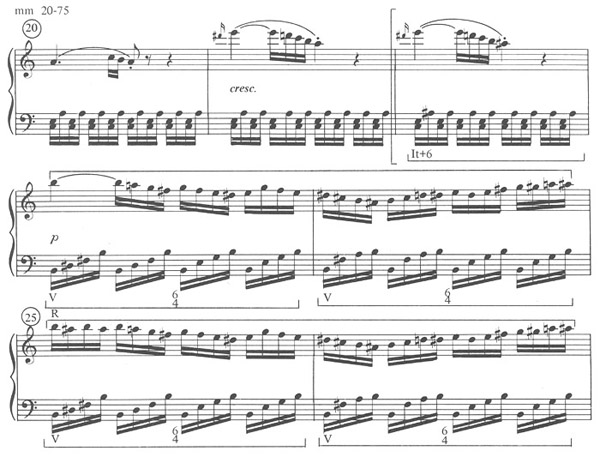
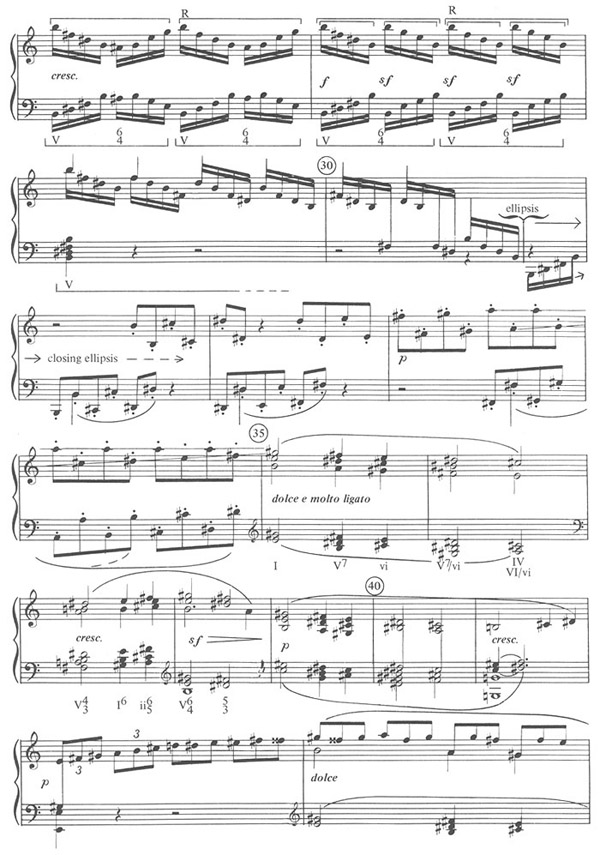
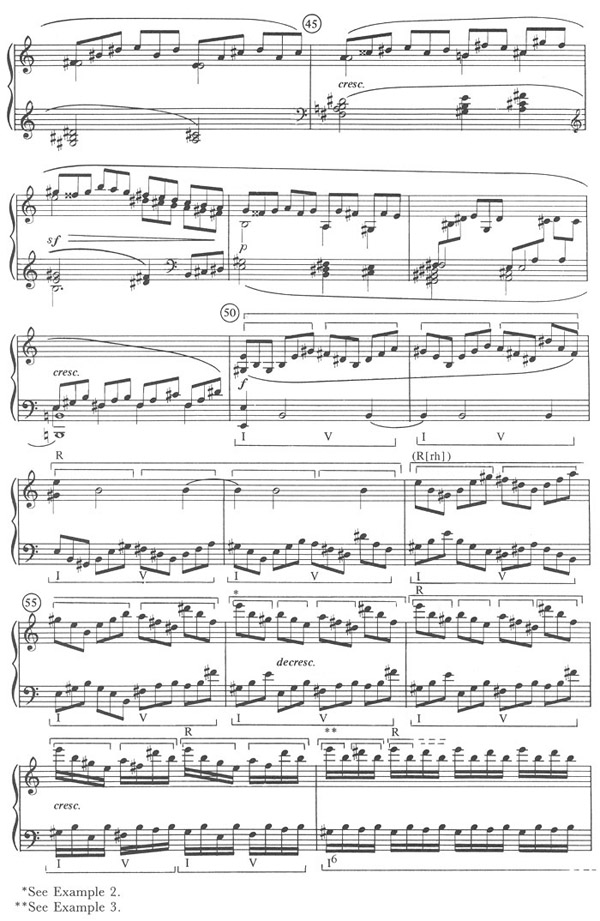
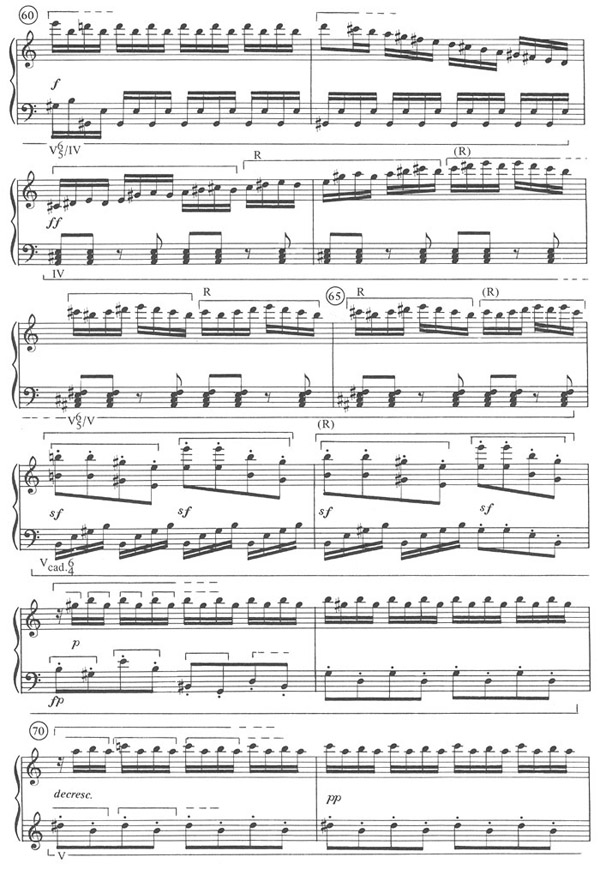
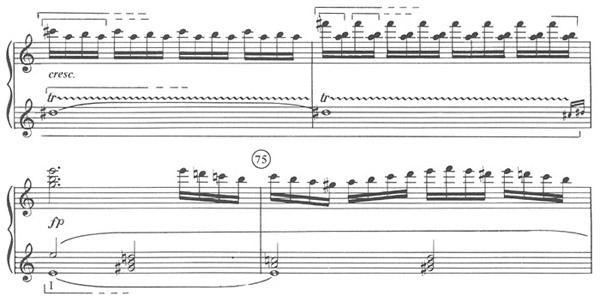
KEY
R: repetition
(R): altered repetition
Chord identification usually includes Roman numerals but not necessarily figured bass.
Brackets
Above staves: span of melodic-contrapuntal pattern
Above inside: individual arpeggio configuration
Between staves: span of left-hand melodic pattern where different from right
Below staves: harmonic span, either pattern (e.g., I-V) or single chord
To bring us to m. 35, the movement, which begins agitatedly on shifting tonal ground, projects C under various transformations. Eventually, C's function goes awry more bizarrely than before and leads, as an Italian 6th, to a B chord. B's arpeggiations relentlessly accelerate into a drawn-out descent. Quietly, octaves re-ascend gradually, step by step, until the right hand's top line stalls on A while its lower line continues unchecked. The pressure rises by degrees as the space shrinks until survival—at least of the line—depends on release of the chord.7
With the arrival of the new tonic, the pressure drops, but, since E major remains far from C, the respite, like the eye of a storm, is uneasy and only temporary. Shortly, we will plunge back into the tempest.
Meanwhile, the tune—stepwise, legato, and lyrical—clarifies an eight-measure expanse within which four-measure phrases nest two-measure rhythmic groups in slow durations. The individuality of the tune, conveyed by its vocal quality, is enhanced by its setting: a gently flowing bass and a chord progression—elaborate by comparison with its surroundings—that avoids strong movement and is enriched by chromaticisms. The startling contrast of the "chorale," in so unlikely a place, stops the surge forward and focuses attention on itself, as with relief we take in its qualities, so peculiarly calm in light of its surroundings.
Unlike the chorale, which is distinguished by qualities that can suggest an individual or agent, there is little about the remainder of the passage that is so highly characterized. It is comprised principally of arpeggiations of various configurations and breadths that convey a single, conventional harmonic progression. The syncopations of mm. 50-53, the chords of mm. 62-66, and the accented eighth-note arpeggios immediately following offer only the merest hints of characterization, features that pull away temporarily from the arpeggiated texture. The individuality of the arpeggios themselves is minimal. Rather, the whole span surges beyond the earlier B swell to drive measure 42's E chord up to the high register in m. 74, from which it falls, with rapidly diminishing force, back to C.
Already in m. 42 the triplet rise out of the chorale's cadence begins to dissolve the chorale and its calm. Then, the velocity increases relentlessly as the durations of the patterns are repeatedly halved. (See the upper brackets in ex. 1.) Twice, a pattern is squashed in the onslaught. (See exx. 2 and 3.)
Example 2: Derivation of m. 56 from mm. 54-55
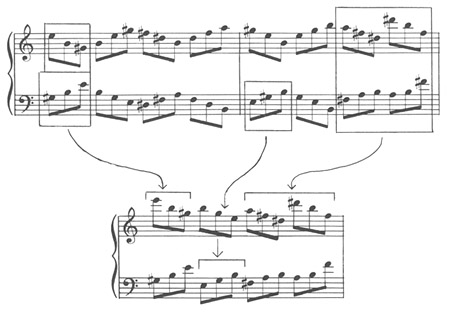
Example 3: Derivation of m. 59 from m. 58
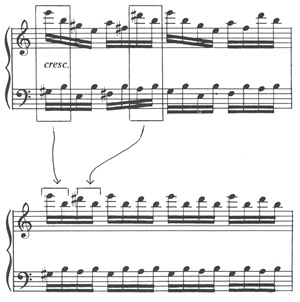
Independently, the relationship between the hands becomes increasingly involved: triplets against stationary syncopations evolve into simultaneous contrary-motion triplets that whirl out of phase with the shift from triplets to sixteenths. The music begins to grow quieter just as the pattern is squashed the first time, but grows louder again with the sixteenths. While the loudness increases, the chordal alternation is reduced to a tonic chord with neighbor notes that brings the line to a loud, pulsating—a roaring—standstill just as the chord reinterprets the neighbor as a seventh and absorbs it. The right hand unhitches itself from the left and dives into IV.
But with the arrival of IV, the tumult increases. Louder than ever, the right hand spirals back up through a new octave every three beats, until it reaches high E and turns around. In conflict, the left hand continues the two-beat norm, but in repeating eighths that are impelled forward only by an upbeat. The frenzy reaches its peak at the nearer approach to the impending V as the right hand, newly re-aligned with the left, reels turbulently around  and up to E. Finally the cadential
and up to E. Finally the cadential  bursts out tempestuously, momentarily halting the on-rush. It expends its power in simultaneous accented eighths before the left hand extends itself, quietly now, upward across two more measures to treble B.
bursts out tempestuously, momentarily halting the on-rush. It expends its power in simultaneous accented eighths before the left hand extends itself, quietly now, upward across two more measures to treble B.
With the storm of activity nearly exhausted, the dominant emerges capable only of desperately intensifying the oscillation to a trill—even the crescendo so high is weak—but this drives the top, spent but still feverish, to  , which subsides into a tonic more welcome even than that of m. 35.
, which subsides into a tonic more welcome even than that of m. 35.
The foregoing portrayal of the Beethoven passage in terms of a storm's inexorable progress is meant to capture each succeeding moment's structural role in the piece's progress and, simultaneously, to characterize the qualities of that progress. It focuses, therefore, on the evolving qualities of action that the piece projects.
The language I have used does not preclude the possibility of claiming that I am thinking in terms of agents in, at least, the indeterminate sense proposed by Fred Maus.8 Furthermore, though the piece led me to an inanimate framing image, the analysis could, perhaps, be reframed in human terms. As it is, one could claim that the storm is an agent.
However, I am not trying to deny that a human framework could be erected. Rather, I am pointing out a distinction between descriptions that focus on the qualities of an individual's character or physical presence and descriptions that focus on acts and the qualities of those acts—and, implicitly, on a distinction between those pieces that suggest one or the other emphasis. The most distinctive aspect of act-oriented descriptions is, I think, the use of verbs and qualifiers that vivify actions; the most distinctive aspect of character-oriented descriptions would be the use of attributive nouns and qualifiers that vivify character or physical traits. Act-oriented analyses will suggest the dynamics of movement and gesture and the processes of change as they proceed over small and large spans. These have been the terms in which I have framed my description of the stormy and dramatic ebb and flow in the Beethoven.
The actions portrayed create particular qualities of time's passage—of rhythm—and it is the rhythms of things, in the most obvious senses of duration and rate of change, that the analysis interprets. Each succeeding intensification is created through small changes in the most obvious and immediately sensed features; each change grows out of what immediately precedes it. The relatively neutral arpeggiations are made turbulently surging by alterations in the length of pattern; the level of beat division; the relation between the two hands, heard as separate entities; the temporal span of each harmony; and, in addition, the melodic contour and register.
Through the sophisticated manipulation of such simple things, the listener's attention is captured and riveted in the flow of the action, and we are swept along in the drama as it takes shape. Here there is no need to posit a persona in order to understand or construct a coherent context for that action.9
Late in The Composer's Voice, it seems that Cone comes to a similar view. The intriguing analysis of Beethoven's Piano Sonata in E Major, op. 109, makes what seems a purely structural point that, however, is summarized as the means of "project[ing] the sonata as a single broad gesture." (p. 151) In the Epilogue,10 Cone returns to the question of utterance, explaining that "it is the gestural aspect of utterance that is simulated, and symbolized, by music." (p. 164) "Like physical gesture," he says, "verbal gesture communicates the speaker's . . . attitude toward what he is saying; or it tries to influence his hearers . . . , not by the sense of the discourse, but by its intensity." (p. 163) Indeed, he goes on to point out that "the gestures of music can be interpreted as symbolic of physical as well as verbal gestures." (p. 164)11
Whatever my disagreement with—or perhaps misunderstanding of—Cone, The Composer's Voice clearly demonstrates how we treat pieces as if they were people. We describe successions of musical events—even whole pieces—as gestures; we even interpret those gestures as if they suggested frames of mind. This, I think, is the conceptual point at which, for Cone, persona becomes the controlling intelligence of gesture.
Furthermore, Cone points out, also in the Epilogue, that musical structure corresponds with extra-musical experiences through structural isomorphism. Thus, the way that that almost mystical word "experience" attaches to music is by the usual mental processes. Music and the rest of life are interpreted together by one and the same brain, with one and the same capabilities and habits. The patterns that it extracts from experience in one domain will probably match, closely enough, patterns in other domains to suggest a common way of thinking of and about them. If we are going to investigate such structure-making potential, we have no choice but to do it in terms of the patterns we know or can imagine based on the ones we know. If our investigations should take shape in sound—a medium ideal for manipulating the continuous, the processive, and the dynamic—then the music we make will share its abstract form with the abstract forms of other experiences.
However, not all those experiences are what might be called human. We have enormous experience as well with non-human objects, concepts, forces, acts. We may, in some sense, understand them as extensions of experiences of being and knowing humans—the terminology that describes storms, I have discovered, associates them with turbulent emotions and raging fevers—but, as individual experience of the world increases and diversifies with age, that relation attenuates to the point of independence from specifically human association.
Our imagination can choose conceptions of inanimate entities to serve as abstract patterns either in creating works of art or in explaining them. Thus Varèse described his music in terms of crystals and colliding masses. Furthermore, any of these conceptions can serve as the source for newly imagined patterns and relations that we create when we imagine new ways to think of the natural world or, presumably, when we write a piece of music. Music can be represented by models drawn from the human world, but it can equally be represented by models drawn from what we know of the non-human world. Or these can stimulate the emergence of new ideas out of old experiences.
1See "Questions about the Persona of Schubert's 'Wanderer' Fantasy," also in College Music Symposium 29.
2As Cone's mention of "symbolic gesture," cited above, hints, we may be in closer agreement than most of The Composer's Voice suggests.
3Here I should point out that, in my talk about dramatic acts, the connotation of "dramatic" is somewhat more specific than the relatively neutral characterization of "drama" that I have cited. To say that something is "dramatic" suggests to me some quality of intense action, paradigmatically, motivated by conflict.
4This formulation of actor and action is derived from Aristotle, Poetics, as quoted in Fred Everett Maus, "Music as Drama," Music Theory Spectrum 10 (1988): 72.
5As I have redefined it, the concept "persona" should probably be renamed, though for the consistency of this paper's argument, I shall continue to use it (with reservations).
6Two caveats are needed here: first the obvious one that the persona-act distinction, like most distinctions, is not absolutely contrastive; pieces or analyses will normally partake of both. Second, while I would normally prefer to place persona or act in the analysis rather than the piece, for the moment, my hearing of the Beethoven about to be discussed places the acts (with trepidation) in the piece.
7James Henry suggested this view of m. 35's interactive dynamics in a graduate seminar at Washington University in Spring, 1988.
8Maus, "Music as Drama" (see note 4 above).
9Beethoven, it seems to me, is particularly adept at compelling a listener's attention through just such manipulations. This capacity marks a number of pieces written at about the same time as the Waldstein (the Appassionata comes to mind).
10See Fred Everett Maus, "Agency in Instrumental Music and Song," also in College Music Symposium 29, on the change of heart evident in the Epilogue.
11This sentence is cited for its association of music with physical-verbal gesture: however, Cone continues to make a point, that "physical gesture is an action that emulates an utterance—an action that tries to speak," with which I cannot agree.


